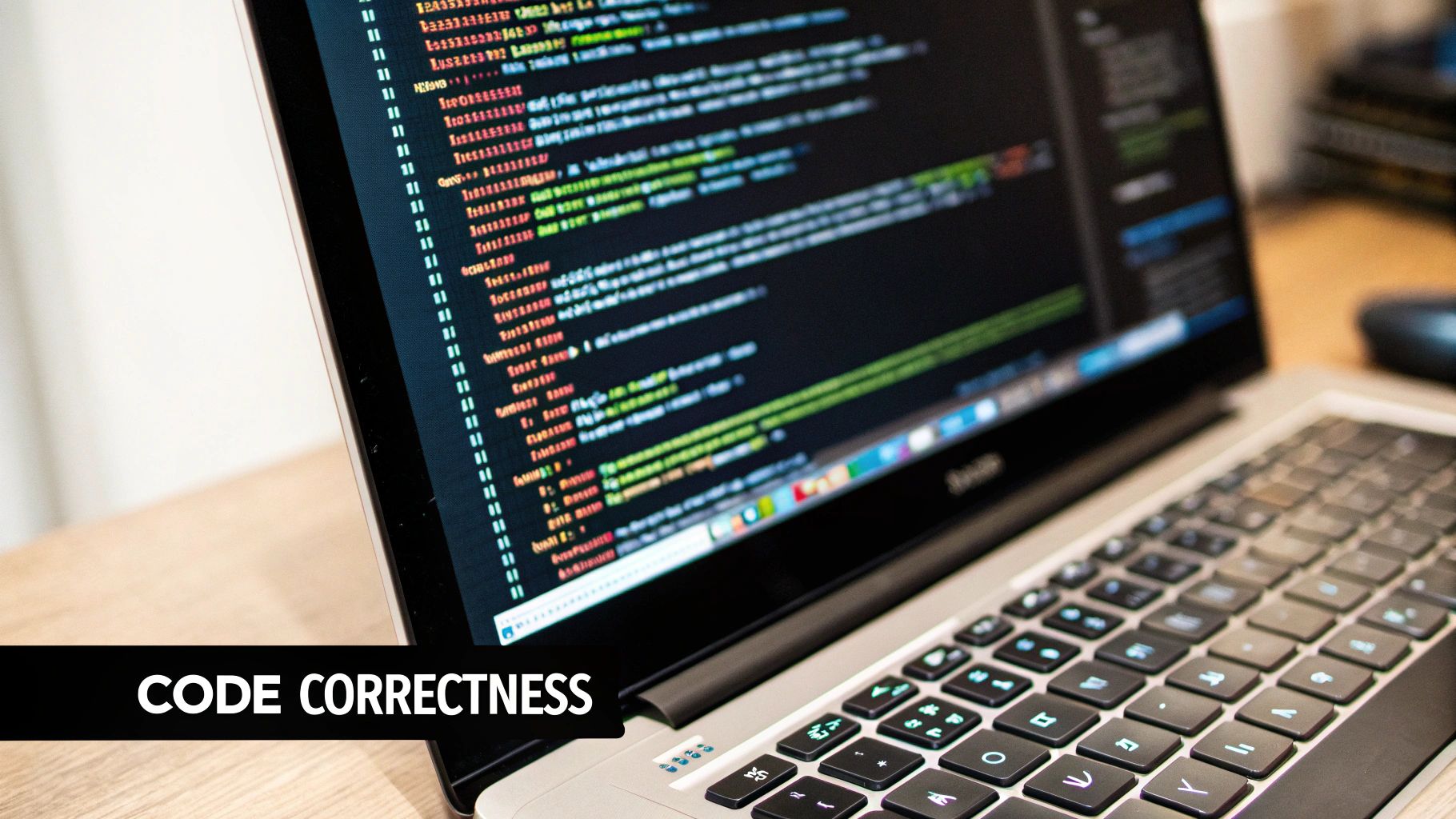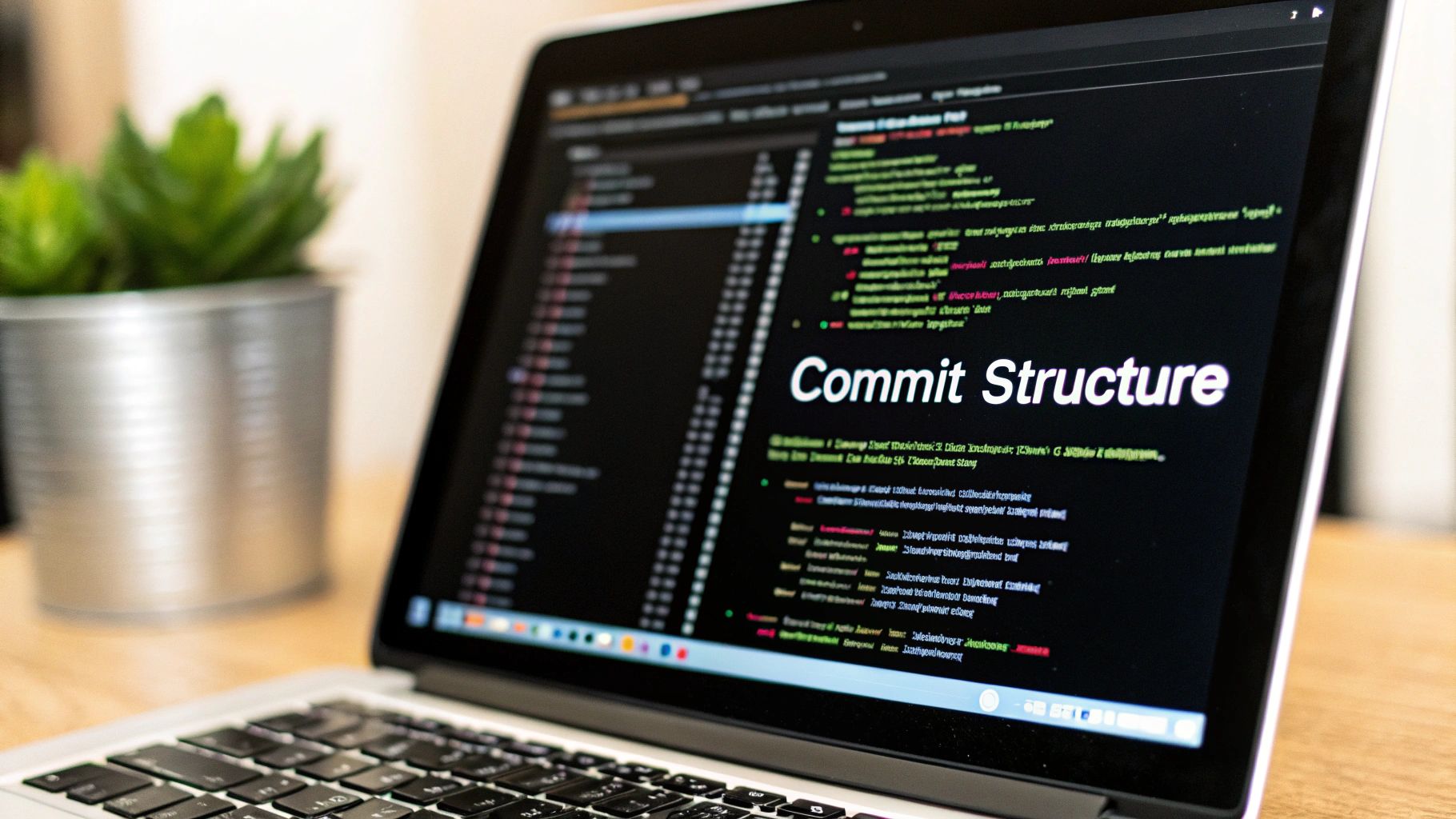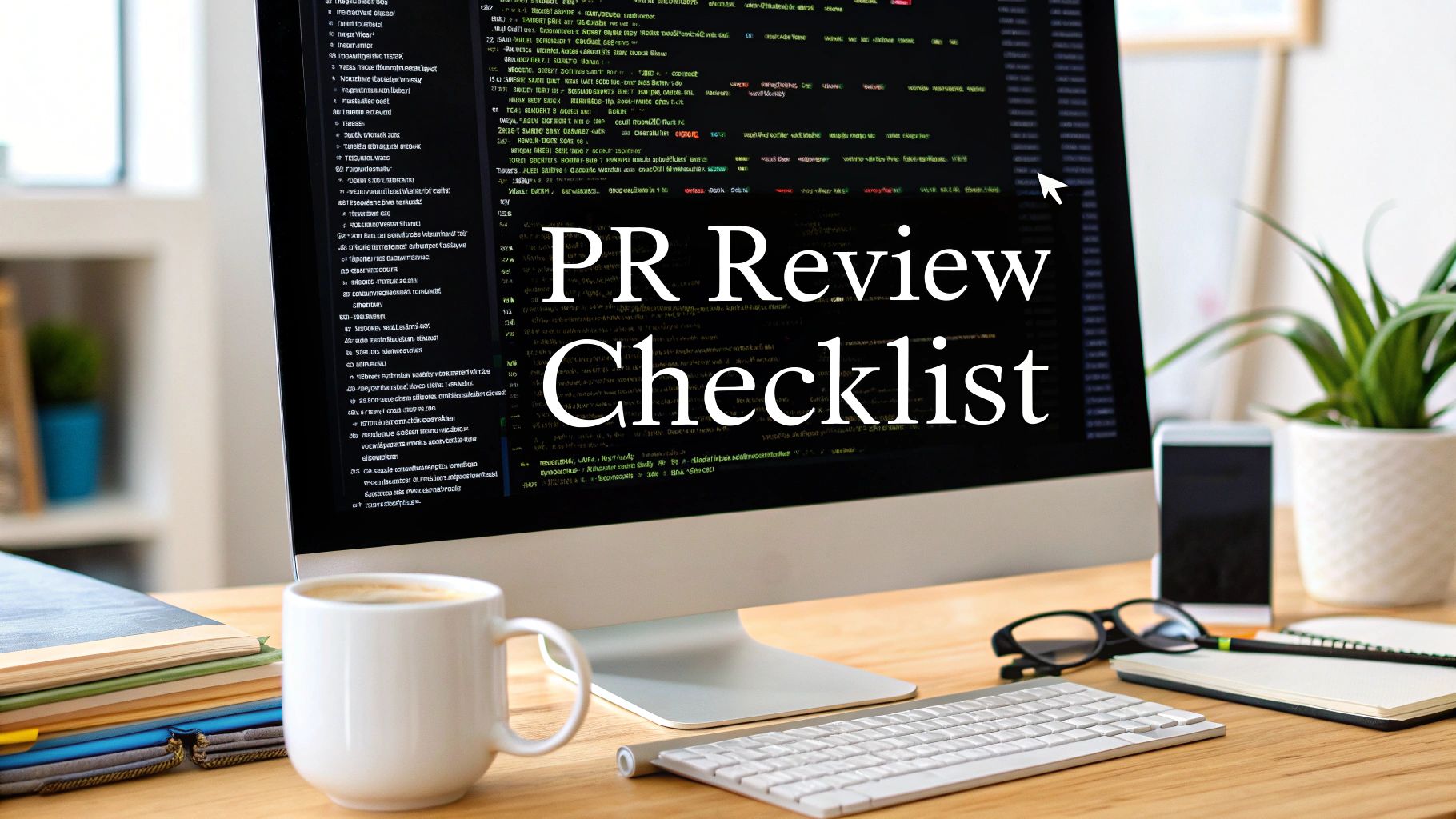8 Critical Components of a GitHub PR Review Checklist
Supercharge Your Code Reviews
Code reviews have become essential for building stable, secure, and maintainable software. From catching critical bugs early to sharing best practices across teams, effective code reviews lead to better software and stronger engineering teams. But what makes a code review truly valuable?
Code reviews started as informal walkthroughs between developers sitting together at a terminal. The rise of Git and GitHub transformed this into an asynchronous process through pull requests (PRs). This shift made it possible for distributed teams to maintain high code quality standards while collaborating across time zones.
A great GitHub PR review involves more than just scanning the code changes. It requires careful attention to detail, clear understanding of project goals, and a structured approach. Using a well-designed checklist ensures reviews are thorough and consistent, regardless of who performs them. This systematic process helps teams catch issues early while creating opportunities for developers to learn from each other.
In this guide, we'll explore 8 key areas that should be part of every GitHub PR review checklist. These insights will help you improve your code reviews, reduce technical debt, and ship better software. Whether you write code, manage engineering teams, or work in DevOps, you'll find practical tips to enhance your review process and strengthen your team's development practices.
1. Code Changes Correctness and Functionality

When reviewing pull requests (PRs), the most essential check is ensuring the code changes work correctly and do what they're supposed to do. While this may seem basic, getting it right is crucial since it directly affects how reliable and maintainable your software will be. You need to verify that the changes fix the original issue without breaking anything else.
Here are the key aspects to check:
- Logic Verification: Does the code produce the right outputs for different inputs? Are there any flaws in the logic?
- Test Coverage: New code needs proper test coverage. Make sure existing tests pass and add new ones for modified code.
- Edge Cases: Check how the code handles unusual situations like null values, empty lists, or very large numbers. Good code anticipates these scenarios.
- Integration: The changes should work smoothly with the rest of the codebase without causing conflicts or side effects.
Here's a real example: Say you're reviewing a PR that adds discount calculations to an online store. You'd check if discounts are calculated correctly for different products and promotions. Your tests would cover basic discounts as well as edge cases like zero discounts or maximum limits. You'd also make sure the new code doesn't break order processing or inventory tracking.
Practical Tips:
- Run the code yourself: Test changes locally to catch obvious issues early
- Try different inputs: Test with valid, invalid and boundary values
- Check unusual cases: Don't just test the normal flow - try edge cases that could break things
- Look for race conditions: For concurrent code, check for timing-related bugs
Teams working with quick release cycles especially need solid code review practices. Finding issues early through thorough correctness checks saves time and prevents problems later.
You might be interested in: Understanding the Importance of Test Coverage. Read also: Best Practices for Handling Edge Cases.
For more on PR workflows, check out this resource: https://www.pullchecklist.com/sitemap-0.xml.
Making code correctness your top priority helps build reliable software that works well and needs less maintenance. This benefits everyone - developers, testers, product managers and users all want code that just works.
2. Code Style and Standards Compliance

Clear code style and standards help teams build better software together. When everyone follows the same guidelines for formatting, naming, and documentation, it becomes much easier to read, maintain, and update code over time. This benefits everyone on the team - from developers to product managers.
The push for coding standards grew naturally as software projects expanded. Early teams struggled when different developers wrote code in their own unique ways. This made it hard to debug issues or bring new team members up to speed. By agreeing on common conventions, teams found they could work together more smoothly.
Key elements of good code style:
- Clean Formatting: Use consistent indentation, spacing, and line breaks to make code structure clear
- Clear Names: Choose descriptive names for variables and functions (e.g.
camelCasefor variables,PascalCasefor classes) - Project Rules: Follow any special requirements for error handling, logging, or security
- Good Documentation: Add helpful comments and documentation to explain what the code does
Benefits:
- Easier to Read: Well-formatted code takes less mental effort to understand
- Better Teamwork: When everyone follows the same patterns, collaboration improves
- Less Maintenance: Clean, standardized code is simpler to fix and enhance later
Tips for Code Style Reviews:
- Use Automated Tools: Set up linters like ESLint or Pylint to catch style issues automatically
- Document Standards: Keep style rules in writing and make sure the team knows them
- Check the Details: Look for consistent spacing and indentation - small things matter for readability
Why This Matters:
Good code style may seem like a small thing, but it makes a big difference. When teams maintain consistent standards through code reviews, they prevent technical problems, work better together, and build code that lasts. This creates value for everyone involved in the project.
3. Documentation and Comments
Good documentation helps teams build software that's easy to understand and maintain. When reviewing pull requests (PRs), checking documentation and comments is just as important as reviewing the code itself. This review ensures others can work with and extend the code effectively - including your future self.
Here are the key areas to review:
-
API Documentation: Clear documentation is vital for any library or module. Teams should document all public APIs to help other developers integrate the code correctly. Tools like Sphinx or JSDoc can help automate this process.
-
Code Comments: While over-commenting should be avoided, strategic comments explaining why certain decisions were made are helpful. These comments provide context about the developer's reasoning, especially for complex logic or non-obvious implementation choices.
-
README Updates: The README file is often a developer's first introduction to a project. Make sure it stays current with any PR changes, including updated setup steps, usage examples, and new functionality. A complete README helps new team members get started quickly.
-
Change Documentation: For bigger projects, maintaining change logs or release notes helps track the project's evolution. This history makes it easier to understand when features were added or bugs were fixed.
Real Example: Consider a PR that adds a new machine learning model. Without good docs, other data scientists might struggle with the model's requirements and limitations. Clear API docs and comments about the model's design choices would make the code much more useful.
Current Context: As software development becomes more collaborative and teams more distributed, clear documentation is essential. Most popular coding style guides now emphasize documentation as a core practice.
Key Documentation Tips:
- Write comments that explain why, not just what the code does
- Keep API documentation in sync with code changes
- Maintain clear setup and usage instructions in the README
- Use consistent documentation formatting across the project
Benefits:
- Better code maintenance
- Smoother team collaboration
- Faster onboarding for new developers
- Better user experience
Challenges:
- Documentation can get outdated
- May need extra review cycles
Thorough documentation review during PRs helps create code that's not just functional but truly usable by the team. While it takes extra effort upfront, good documentation saves significant time and effort as the project grows.
4. Security and Performance Impact

When reviewing code, examining security and performance implications is essential. Skipping this step can open the door to security breaches and slow down your application. Whether you're a Data Scientist working on data pipelines or an IT Analyst checking deployed apps, this review is crucial. Even Product Managers and Agile Coaches need to understand these aspects for effective planning.
The software industry has shifted from treating security as an afterthought to making it a core part of development. Tools like DevSecOps now integrate security checks throughout the process. Similarly, performance testing has moved from post-release to becoming a key development priority, driven by users who expect fast, responsive apps.
Key elements of security and performance reviews:
- Security scans: Use tools to check for SQL injection risks, cross-site scripting (XSS), and outdated dependencies
- Performance testing: Set baseline metrics and compare against new changes
- Resource monitoring: Track CPU, memory, disk, and network usage to spot bottlenecks
Practical review tips:
- Check database queries: Use parameterized queries instead of string concatenation to prevent SQL injection
- Look for exposed credentials: Make sure API keys and passwords aren't visible in code or logs
- Test input validation: Verify all user inputs for correct data type, length, and format
- Monitor memory use: Watch for memory leaks and inefficient data structures
- Test different user scenarios: Changes that help some users might slow things down for others
Real example: Consider a pull request that adds a new database feature. Without proper input checks, attackers could inject harmful SQL code. And if the feature uses too much processing power, it could make the whole app run slowly.
Benefits of thorough reviews:
- Better security: Catch and fix vulnerabilities before they cause problems
- Faster apps: Well-optimized code means better response times and happier users
- Lower costs: Finding issues early prevents expensive fixes later
You might find these resources helpful: Understanding Website Sitemap Structure for documentation navigation and [Best Practices for Secure Coding] for security guidelines. This knowledge helps DevEx Engineers create better tools and helps Cloud Engineers understand how code changes affect their systems.
5. Test Coverage and Quality
Good tests are the foundation of reliable software. They help catch bugs early, prevent regressions, and make code easier to maintain over time. Let's explore how to evaluate test quality when reviewing pull requests.
Testing approaches have shifted from manual-only testing to automated checks. Modern tools like JUnit for Java and pytest for Python allow developers to automatically verify their code's behavior. This leads to faster feedback and fewer bugs reaching production. The rise of CI/CD has made automated testing even more essential.
Key Areas to Check During Review:
- Unit Test Coverage: Look at what percentage of code has unit tests. Focus on testing critical logic and edge cases rather than hitting arbitrary coverage targets.
- Integration Testing: Verify that tests check how different parts of the system work together. This catches issues that unit tests might miss.
- Edge Cases: Review how the code handles unusual inputs, boundary conditions, and error scenarios. These often cause unexpected bugs.
- Test Quality Metrics: Consider factors like test run time, test code complexity, and flaky tests that pass/fail inconsistently.
Tips for Better Test Reviews:
- Use test coverage reports from your CI system to find gaps
- Check that tests don't share state or external dependencies
- Look for clear, specific test assertions that verify expected behavior
Real Examples:
A financial app's unit tests check basic interest calculations but miss negative interest rates, potentially causing incorrect results. Or a web app lacks integration tests between frontend and backend, leading to data display bugs.
Benefits:
- More Reliable Code: Thorough testing helps catch issues early
- Safe Changes: Tests verify that updates don't break existing features
- Easier Maintenance: Well-tested code is simpler to modify and improve
While writing and maintaining tests takes time and effort, the long-term benefits far outweigh these costs.
Careful review of test coverage and quality helps teams deliver more stable, maintainable software. This makes it a vital part of any pull request checklist.
6. PR Description and Context
A strong PR description helps developers conduct efficient code reviews by providing key context around the changes. This section outlines how to craft clear PR descriptions that enable reviewers to quickly understand and evaluate code changes.
Key Benefits of Good PR Descriptions:
- Speeds Up Reviews: Helps reviewers quickly grasp the changes and their purpose
- Prevents Mistakes: Clear context reduces misunderstandings and oversights
- Builds Team Knowledge: Documents decisions and approaches for future reference
- Enables Automation: Well-structured descriptions support automated changelog generation
- Improves Collaboration: Creates shared understanding between author and reviewers
Essential Elements to Include:
- Issue Links: Connect to related tickets and bugs (Example: "Fixes #123")
- Change Summary: Explain what changed and why (Example: "Added JWT auth for better security")
- Technical Details: Describe implementation choices and alternatives considered
- Test Instructions: List specific steps to verify the changes work correctly
Sample PR Description: Added last_login field to User model to enable activity tracking and personalized recommendations based on recent user behavior.
To test:
- Run migrations
- Login with test account
- Verify last_login is updated
- Check activity dashboard shows recent logins
Related: #456 (Performance improvements)
Tips for Writing PR Descriptions:
- Start with a clear problem statement
- Link all relevant issues and tickets
- Document any special deployment steps
- Include specific testing instructions
- Explain technical decisions and tradeoffs made
The importance of detailed PR descriptions has grown as development teams become more distributed. While writing thorough descriptions takes time upfront, it saves significant effort during reviews and helps ensure higher quality code.
The PR description deserves its place in code review checklists because it directly impacts review efficiency and effectiveness. Clear descriptions enable better feedback, fewer bugs, and faster delivery of working code.
7. Dependencies and Configuration
Reviewing dependencies and configuration changes is a vital part of code review that many developers overlook. When done poorly, issues with dependencies and configs can lead to broken builds, security holes, and production outages. Let's explore how to review these elements effectively.
Key areas to examine during review include:
- Package Dependencies: New or updated libraries that your code relies on. Even minor version changes can break functionality.
- Config Files: Changes to
.yaml,.json,.ini, or.xmlfiles that control application settings and external connections. - Environment Settings: Variables and parameters that change behavior across dev, test, and production environments.
- Build Configuration: Updates to build scripts and CI/CD pipelines that affect how code is compiled and deployed.
Package management has come a long way from manual dependency tracking. Modern tools like npm, pip, and Maven make it much easier to declare and update dependencies. Similarly, infrastructure-as-code tools help manage configurations across environments.
Real Example: Consider a data science project using TensorFlow. A pull request updates TensorFlow to get new features, but the new version removes a key function used in data preprocessing. Without careful review, merging this change would break the application.
Tips for Reviewing Dependencies:
- Check Version Compatibility: Make sure dependency updates don't conflict with other packages
- Look for Security Issues: Use security scanning tools to check for known vulnerabilities
- Test Config Changes: Verify that config updates work correctly across all environments
- Stage and Test: Run thorough tests in a staging environment before approving major changes
Benefits:
- Better performance from updated dependencies
- More consistent deployments
- Improved security through patches
Risks:
- Package conflicts and breaking changes
- Extra testing overhead
- Potential deployment issues
For a deeper understanding, read this guide on Configuration Management Best Practices. You can also check our full site structure at https://www.pullchecklist.com/sitemap-0.xml.
Taking time to properly review dependencies and configuration changes helps prevent issues before they reach production. This investment in careful review pays off through more stable and secure applications.
8. Branch and Commit Structure

Having a clear approach to branching and commits is essential for team collaboration and code maintenance. While often overlooked during reviews, how you structure your changes directly impacts your project's long-term health.
Why does this matter? Think about debugging a production issue months after releasing a feature. Trying to understand what happened through unclear commit messages and disorganized changes makes troubleshooting much harder. A clean, well-documented history helps teams trace code changes and understand why decisions were made.
Key Areas to Check:
- Commit Messages: Messages should tell both what changed and why. Avoid vague descriptions like "fixed bug" or "updated code"
- Branch Names: Follow consistent patterns like
feat/login-formfor features,fix/button-alignmentfor bugs, andhotfix/security-fixfor urgent fixes - Single-Purpose Commits: Each commit should focus on one logical change instead of mixing unrelated updates
- Clean History: The branch should be up-to-date with its target and have no merge conflicts
Benefits:
- Makes it easy to track how code has changed over time
- Helps reviewers understand and evaluate changes
- Allows precise rollback of specific changes when needed
Practical Review Tips:
- Check if commits are logically grouped and self-contained
- Verify the branch is current with its target branch
- Look for descriptive commit messages that explain reasoning
How We Got Here:
As teams adopted tools like Git for version control, good branch and commit practices became crucial. Teams developed approaches like feature branching to handle parallel work on complex projects.
Real Example:
Consider a team adding user authentication. They create a branch feat/new-auth with focused commits like:
- "Add OAuth integration for Google login"
- "Create user registration form"
- "Update user database schema"
This clear structure makes it easy to understand, review, and modify the changes if needed.
Learning from Others: Many open-source projects demonstrate excellent branching and commit practices. Studying how they organize changes can help teams develop better workflows.
By reviewing these aspects carefully, teams build a stronger codebase that's easier to maintain and work with over time. The extra effort in structuring changes well pays off through faster development and fewer issues down the road.
GitHub PR Review Checklist: 8 Best Practices Comparison Guide
| Method | Difficulty | Time Required | Results | Best For | Key Benefit | |---------------------------------------|--------------|----------------|-------------------|----------------------------|--------------------------| | Code Changes Correctness and Functionality | Medium 🔄 | Medium ⚡ | Comprehensive 📊 | Regression testing | Ensures functionality ⭐ | | Code Style and Standards Compliance | Low 🔄 | Short ⚡ | Consistent 📊 | Code maintenance | Enhances readability ⭐ | | Documentation and Comments | Low 🔄 | Short ⚡ | Clear 📊 | Knowledge sharing | Aids onboarding ⭐ | | Security and Performance Impact | High 🔄 | High ⚡ | Critical 📊 | Vulnerability mitigation | Reduces risks ⭐ | | Test Coverage and Quality | Medium 🔄 | Medium ⚡ | Reliable 📊 | Stability assurance | Prevents regressions ⭐ | | PR Description and Context | Low 🔄 | Short ⚡ | Informative 📊 | Review clarity | Improves communication ⭐ | | Dependencies and Configuration | Medium 🔄 | Medium ⚡ | Stable 📊 | Environment consistency | Minimizes issues ⭐ | | Branch and Commit Structure | Low 🔄 | Short ⚡ | Organized 📊 | Change tracking | Simplifies rollback ⭐ |
Level Up Your Workflow
High-quality software relies on smart code reviews. By following the eight key review components discussed above - code correctness, style standards, documentation, security and performance, test coverage, PR descriptions, dependencies, and branch structure - you can make your development process much more effective. These guidelines help create reliable code while supporting collaboration and learning across your team. Making these checks part of every pull request, no matter how small, builds consistent quality standards.
Keep refining your process over time. Check in regularly with your team about what's working and what could be improved in code reviews. Stay current with code review tools and industry practices - for example, code analysis tools now provide deeper automated insights that complement human review.
Key Takeaways:
- Following a thorough checklist leads to better code quality
- Detailed code reviews help teams learn from each other
- Regular process improvement keeps reviews effective
- New tools can enhance code review efficiency
Want to improve your team's code reviews? Pull Checklist helps automate GitHub PR reviews with smart checklists. Set required checks, block merges when needed, and track review status - all within your pull requests. Using consistent checklists helps maintain quality even when reviewing unfamiliar code. The tool includes customizable templates and reporting to boost team collaboration.
